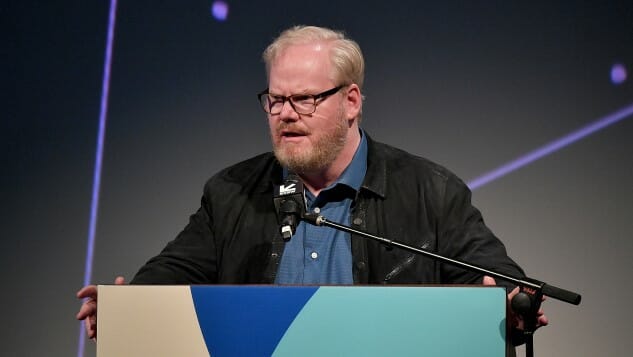Jim Gaffigan’s Anti-Craft Beer Op-Ed Is Equal Parts Pointless and Short-Sighted
Photos via Getty Images, Michael Loccisano
Thanks to the fact that the Great American Beer Festival is only a few days away, the craft beer social-media galaxy is abuzz with the usual mixture of hype, advertisement and nitpickery. It’s also perhaps the reason why CBS News reached out to comedian Jim Gaffigan for a small op-ed on the state of American beer, to coincide with a time when beer-related Google searching is at its yearly zenith. More unfortunate? The sorry nature of Gaffigan’s essay, which attacks the very idea of any beer style that doesn’t conform to the most basic and pedantic of outlines. In it, Gaffigan proclaims himself a defender of “beer that tastes like beer.”
The Brewers Association, the trade group that lobbies on behalf of the American craft brewing industry, has already responded in the kind of way they must respond, due to the nature of the organization—in a friendly, well-mannered, bridge-building invitation to join them for a beer. This response, on the other hand, will simply call Gaffigan’s essay what it is: The short-sighted and piteous critique of a writer annoyed at the fact that he’s being left behind by the world.
There is a breed of person in the world who becomes personally offended by the idea of people enjoying something that they themselves don’t understand. This is something that Gaffigan often discusses in his comedy, in fact—and we are indeed fans of Gaffigan’s comedy—such as in his segment slagging seafood as a whole, but the difference is that the comedian’s seafood material is delivered within the confines of a stand-up set, and contain a backbone of satire because they’re delivered by Jim Gaffigan, the Crotchety On-Stage Character. THAT Jim Gaffigan is a construction of sorts; a parody of entitled, befuddled middle-aged white men. By contrast, there aren’t any jokes to speak of in the CBS News piece—instead, it’s a genuine venting of apparent frustration from Gaffigan, which suggests he falls into that bracket of people who illogically see themselves as imbued with the sole right to decide the definition of “what beer tastes like.” And that, suffice to say, is an incredibly presumptuous thing to believe. The entire piece comes off like one of Andy Rooney’s fuzzy rants on Sixty Minutes.
I mean really, Jim—how can you stick a line like “a beer preference is personal” into this essay, and then immediately launch into derision of every other person’s taste within the next few paragraphs? How can you describe the picked-upon feeling you have when your brothers say you like “fancy beer,” and then fail to see that you’re doing the exact same thing to anyone who enjoys anything that falls outside your extremely narrow definition of “beer that tastes like beer”? How does your definition of Americans “losing their way” become “enjoying a wide variety of beer,” as opposed to drinking the same thing every day in ant-like conformity? What is it about the concept of choice that makes you angry, exactly?
There are so many easy examples of how this is a fallacious and limited line of thinking, especially if you apply the same line of thinking to any other aspect of lifestyle or taste. For instance: Gaffigan is a well-known lover of steak, something he’s expounded upon many times in his comedy—he talks in the piece below about how much he loves “the steakhouse experience.” If you said to him, “Why do you need dry-aged ribeye? Are you that bored with Applebees sirloin?”, he’d no doubt call it a ridiculous comparison, and say that the two are meant to serve entirely different niches. So it is with beer. One doesn’t berate a person, saying “Why would you need pork, when you’ve got chicken?”, and it’s equally ridiculous to ask someone why they need pale ale when they’ve got Bud Light. One is in no way a substitute for the other. You might as well ask someone why they pursue their chosen hobby: “Are you that bored with books and movies, that you need THIS?”
-

-

-

-

-

-

-

-

-

-

-

-

-

-

-

-

-

-

-

-

-

-

-

-

-

-

-

-

-

-

-

-

-

-

-

-

-

-

-

-








































